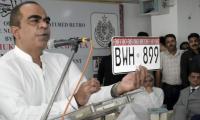ISLAMABAD: After 39 months of incarceration, the longest serving detainee of the National Accountability Bureau (NAB), bureaucrat Ahad Cheema, is out on bail granted by the Lahore High Court (LHC).
The list of cases he was being investigated for is a long one. NAB investigated Cheema in the Ashiana Housing Scheme, Quaid-e-Azam Thermal Company (Pvt) Limited or QATPL (Bhikki power plant), the Punjab Thermal Power (Pvt) Company or PTPL (Trimmu, Jhang power plant), Lahore Development Authority (LDA) City Housing Scheme, Paragon City Housing Scheme, the Lahore Metro Bus System (MBS), Ravi Riverfront Urban Development Project (RRUDP) and other LDA schemes.
Cheema had to remain behind bars for a long period as NAB kept opening and shutting inquiries and investigations against him one after another. He was arrested in February 2018, when the Pakistan Muslim League-Nawaz (PML-N) government was still in place. The feasibility study of the RRUDP, which is now being showcased as the flagship project of Prime Minister Imran Khan, had also been prepared by Cheema as the LDA director general.
Cheema had been awaiting a decision on his bail application since March 2019. He was initially taken into custody by NAB in the Ashiana Housing Scheme case. Except for him, all the accused in this case, including Shahbaz Sharif, Fawad Hasan Fawad, Bilal Kidwai, Imtiaz Haider and others, have already been granted bail by the superior courts.
During his custody, NAB opened an investigation against Cheema on the charge of assets beyond means and the LDA City Housing Scheme. However, after 16 months NAB closed the LDA City case, and as a result, the accountability court granted him bail.
According to the details provided by informed people during discussions with The News, the story of the number of cases against Cheema probed by NAB and subsequently closed presents an instructive picture.
The NAB executive board recently approved the closure of an inquiry against the QATPL, which had set up the famous 1181 MW Bhikki power plant, one of the largest power projects in Punjab’s history in terms of cost. A few weeks ago, NAB also shut the inquiry against the PTPL, which is undertaking a 1181 MW Punjab power plant in Jhang -- another project of the same scale and magnitude. The cost of both the projects combined is around $2 billion.
During his 17 years of service as a district management group (DMG) officer, Cheema worked as the Lahore deputy commissioner, twice as the LDA chief, the Punjab education secretary and QATPL CEO. In recognition of his outstanding and meritorious services in constructing the Lahore metro, Cheema was conferred the Tamgha-e-Imtiaz by the President of Pakistan.
A senior official serving in Punjab said that the Bhikki plant has been running successfully for almost two years now and as a result, the provincial government, being its owner, earned Rs6.4 billion profit from it till December 2019. He said Cheema was also part of the team that successfully negotiated the Orange Line Metro Train Project for Lahore, saving Rs55 bn post-bidding. When civil works were transferred to the LDA, another Rs6-7 billion were saved on account of competitive bidding.
Cheema made his mark very early in his career, when, way back in 2005, he was picked by Chief Minister Pervez Elahi to manage his hallmark project “Parah Likha Punjab”, supported by the World Bank. He was made the coordinator of the initiative. The then government always took immense pride in its success, and donor agencies also showcased it as worth emulating.
In bureaucratic circles, Cheema is nicknamed ‘The Metro Man’. Shahbaz Sharif as the chief minister had selected him to supervise and monitor the MBS project. Cheema was appointed the LDA chief in March 2012 to complete the project in a record 11 months. It was concluded without relaxing even a single rule or regulation. An amount of Rs29.8 billion was utilised in a short span of time. In the completion of the MBS, many engineering feats were achieved for the first time in Pakistan. The second longest BRT flyover of Asia, measuring 8.2 km, was completed in a record time of 230 days. Acknowledging his performance in the Bhikki power project, the Punjab government had entrusted Cheema with another 1200 MW project at Trimmu (Jhang). Arif Saeed, son of late Chaudhry Ahmad Saeed of the Servis Group of Industries, who had volunteered as the QATPC chairman, says the QATPC is a remarkable example of the public sector achieving unprecedented results at a speed private sector companies would do well to emulate. He claims that if one man is to be credited for this other than Shahbaz Sharif it is Cheema. “While there have been several people responsible for providing leadership and vision, Cheema’s relentless efforts have been instrumental in setting new benchmarks in the power sector. The task before the management team was to devise an evaluation mechanism for bidding, attract world-class companies to create real competition, and to arrange the largest ever project financing syndication done without a sovereign guarantee by Pakistani banks, saysArif Saeed, who is known for his no-nonsense and blunt talk in business circles.“In just two and a half years, Cheema and the team he assembled contrived to save the public exchequer and the consumer Rs40 billion in the project procurement alone. Add to that Rs6 billion in annual fuel savings and huge dividends for consumers of electric power,” he added. Cheema’s well-wishers and friends claimed that the total estimated cost of all projects undertaken by him was roughly Rs280 billion, excluding the LDA City which itself is a multi-billion-dollar project. They believe that the savings and financial contributions achieved by him, running into hundreds of billions of rupees, may actually surpass NAB’s total claim of direct and indirect recoveries in its 22 years of existence.
In its order, the LHC wrote that it is a fit case where bail is to be granted on the grounds of “unconscionable delay” as elaborately explained by the Supreme Court in different judgments.
Committee chairman proposes a series of measures to ensure fairness and transparency in recruitment process
Kundi points out lack of progress in modernising police services despite significant resources
Saif says that Imran Khan directed him to consult with national political parties to establish common agenda
Both leaders exchange views on current political scenario and deliberate on their upcoming meeting







